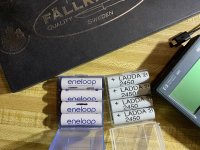I've used Swarovski ELs for the last 20 years (two pairs in all that time). Out if interest and because I found a good deal I just bought a pair of Kite APC Stabilized 10x30s. Although it's easy to tell they are not high end optics, the experience of looking at a bird and switching on the stabilizer is almost a religious one, like suddenly achieving inner peace! I urge you to try it if you haven't. As soon as a company brings out a top of the range 10x42 IS binocular I'm trading my ELs!
Sean
I just had the occasion to briefly(!) test the stabilised Kite 10x30 at the store today and, I have to agree, the stabilisation really is a considerable bonus regarding viewing comfort (“peaceful” might be a good word indeed) and effective detail you can pick up. A very nice sensation. Surprisingly useful for a 10x, probably not that much for an 8x, but certainly for a 12x.
Still, it lost a bit of ‘pure optics’ sensation which I like (see my previous post) and it makes the binoculars bulky for 30mm ones and a bit strange. I was pleasantly surprised the weight was really OK however! This is probably partly due to the somewhat higher use of plastic.
I think I will stick to classic binoculars in the sizes up to 32mm. It just seems to make more sense to me, as choosing 30-32mm binoculars is also because of size and weight, in my personal case. And I wouldn’t go to 12x on 30mm binoculars personally, because of the smaller exit pupil.
But that is just my personal opinion for my use of binoculars.
However, the day I will upgrade my older 10,5x45mm, I might be very interested in their 12x42mm stabilised that is coming (if I understood correctly) or a similar one. By than, more info, feedback from people using them etc. will probably be available, maybe also more models to choose from. (But I suppose that if Swarovski/Leica/Zeiss would produce such a pair, prices would probably be far beyond my budget, but maybe the Kite will be good enough.)
That would fit in more logically in what looks like an almost ideal setup for me: a pocketable and light-weight 8x25mm, a high quality 8x32mm as my mostly used pair of binoculars (on walks, on the bike, but also as a good companion when also carrying a spotting scope), and a 10x42/50mm for low-light&long-distance viewing not while on longer walks, and the spotting scope. (Just keeping a decent 8x30 as back-up and loaner.) Since today, I think making the 10x42/50mm a stabilised 10/12x42/50mm might make sense, if weight, optics and price are OK! But that would be for somewhere in the future...







